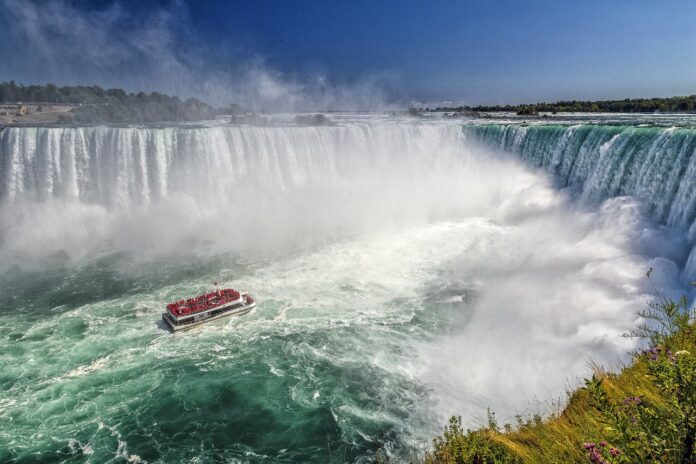The world-famous Niagara Falls is an extraordinary and unique natural wonder. Majestic and powerful, it attracts millions of visitors each year who come to witness its breathtaking beauty firsthand. While it may not be the tallest waterfall in the world, its allure lies in its immense scale, making it one of the most powerful waterfalls on the planet.
Facts About Niagara Falls
- Border Between Two Countries: Niagara Falls straddles the border between Canada and the United States, giving citizens of both countries access to its spectacular views.
- Water Flow: The volume of water cascading over Niagara Falls varies with the season and rainfall, but it often exceeds 5,700 cubic meters per second.
- Height: Niagara Falls is relatively modest in height at just 53 meters, of which only 21 meters are visible due to obstructing rocks. For comparison, Angel Falls in Venezuela, the world’s highest waterfall, stands at 1,054 meters.
- Hydropower Source: Several power plants have been constructed beneath Niagara Falls, harnessing its energy to generate electricity.
- Best Views: Most tourists agree that the view from the Canadian side is more impressive than from the American side.
- Three Waterfalls: Niagara Falls is actually composed of three separate waterfalls, one of which is 323 meters wide, while another spans 792 meters. The third is much smaller.
- Nearby Bridge: Just a few hundred meters downstream from Niagara Falls, a bridge spans the river, allowing both vehicles and pedestrians to cross.
- Geological Age: Scientists have determined that Niagara Falls is relatively young by geological standards, being only about 6,000 years old.
- Naming: The falls are named after the Niagara River, and the term “Niagara” is sometimes used to refer to the falls themselves.
- Erosion and Movement: About 11,000 years ago, Niagara Falls existed in a different location. Erosion caused it to move to its current site.
- Historical Visitors: Napoleon Bonaparte’s brother visited Niagara Falls in the early 19th century.
- Historical Use of Power: Local residents began harnessing the power of Niagara Falls as early as the mid-18th century, using it to operate mechanisms in tanneries, sawmills, and gristmills.
- Jumping Off the Falls: Both Canadian and American laws explicitly prohibit attempts to jump off Niagara Falls. However, there are at least 16 documented cases, most of which ended tragically. The first person to survive such a jump was Sam Patch, who made the daring leap in 1829. Annie Taylor, a 63-year-old woman, became the first person to survive a descent over Niagara Falls in a barrel in 1901.
- Tightrope Walk: In 2012, an acrobat walked 550 meters on a tightrope between the Canadian and American sides of Niagara Falls. To allow this, authorities in both countries temporarily lifted a 128-year-old ban on such stunts.
- Erosion Continues: Due to ongoing erosion of the rock formations, Niagara Falls is gradually retreating upstream, a process also seen at Victoria Falls.
- Frozen Falls: There have been two documented instances of Niagara Falls freezing completely, in 1848 and 1912.
- Falling Fish: Along with the water, a significant amount of fish also plunge down the falls, but about 90% of them survive the drop, according to scientists.
- Water Usage Comparison: The average family would take about seven and a half years to use the amount of water that flows over Niagara Falls in just one second.
- Fines for Unauthorized Jumps: An unauthorized attempt to descend Niagara Falls carries a fine of $10,000.
- Electricity Production: Niagara Falls is the largest producer of electricity in New York State, with the combined power output of its plants totaling 4.4 gigawatts.
- Tourist Attraction: Nearly 30 million people visit Niagara Falls each year.
- Not the Tallest: The largest waterfall in the Niagara complex, “Horseshoe Falls,” is not the tallest in the world—there are nearly 500 waterfalls on Earth that are taller.
- Future Erosion: Scientists predict that soil erosion will eventually destroy Niagara Falls in about 50,000 years, with the smaller American section disappearing within 5,000 years.
- Oldest National Park: Niagara Falls is home to the oldest national park in Canada, Niagara Falls National Park.
- Slowdown of Erosion: Niagara Falls used to retreat by 1-1.5 meters per year, but after the construction of hydroelectric plants, this rate has been slowed to about 30 cm per year.
- Power Output: The power generated by Niagara Falls is estimated at around 5 million horsepower.
- Mist Everywhere: Standing near the falls without getting wet is impossible, as the air is filled with tiny water droplets.
